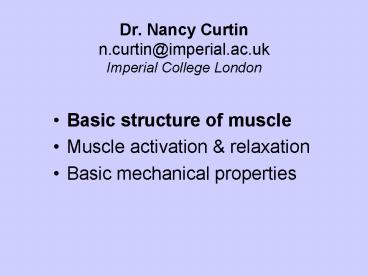Basic structure of muscle - PowerPoint PPT Presentation
1 / 44
Title:
Basic structure of muscle
Description:
Krebs cycle. Electron transport chain. F0F1 ATP synthase. Pathways (e.g. b-oxidation) ... fat metabolism (b-oxidation), the Krebs cycle, electron transport chain are ... – PowerPoint PPT presentation
Number of Views:53
Avg rating:3.0/5.0
Title: Basic structure of muscle
1
Dr. Nancy Curtinn.curtin_at_imperial.ac.ukImperial
College London
- Basic structure of muscle
- Muscle activation relaxation
- Basic mechanical properties
2
Books used for this lecture
Tortora Grabowski, Principles of Anatomy and
Physiology, 9th edition, 2000, John Wiley Sons,
Inc. Widmaier, Raff Strang, Vander, Sherman
Lucianos Human Physiology, 9th edition, 2004,
McGraw-Hill Companies, Inc. Sherwood, Human
Physiology, 3rd edition, 1997, Wadsworth
Publishing Co. Jones et al., Skeletal Muscle
from Molecules to Movement, 2004, Churchill
Livingstone.
The most important slides
3
Outline
Introduction
Tissue components
Orders of structure (big to little)
Structures for activation relaxation
Structures for contraction (force power)
Structures for energy supply
Structures for adaptation repair
4
Muscle is a biological machine
Muscle converts chemical energy stored in
adenosine triphosphate (ATP) into mechanical work
and heat
5
Outline
Introduction
Tissue components
Orders of structure (big to little)
Structures for activation relaxation
Structures for contraction (force power)
Structures for energy supply
Structures for adaptation repair
6
Composition of skeletal muscle
- 75 water
- 20 protein
- myosin (60)
- actin
- Tropomyosin, troponin, etc.
- 5 metabolites, buffers, inorganic salts, etc
7
(No Transcript)
8
Epimysium surrounds whole muscle
9
Outline
Introduction
Tissue components
Orders of structure (big to little)
Structures for activation relaxation
Structures for contraction (force power)
Structures for energy supply
Structures for adaptation repair
10
Six orders of muscle structure
Muscles Fascicles Fibres Fibrils Filaments
Molecules
11
(No Transcript)
12
Six orders of muscle structure
13
(No Transcript)
14
Six orders of muscle structure
15
Electron micrograph of a sarcomere showing
filaments
16
Electron micrograph of a sarcomere showing
crossbridge
17
Outline
Introduction
Tissue components
Orders of structure (big to little)
Structures for activation relaxation
Structures for contraction (force power)
Structures for energy supply
Structures for adaptation repair
18
bone
tendon
Skeletal Muscle - tissue components
fascicle
muscle fibre
19
Muscle fibre
20
Muscle fibre - closer look
Structures involved in activation and relaxation
21
Outline
Introduction
Tissue components
Orders of structure (big to little)
Structures for activation relaxation
Structures for contraction (force power)
Structures for energy supply
Structures for adaptation repair
22
Muscle fibre - closer look
myofibrils
Structures involved in contraction (force power)
23
Sarcomere structure
Z to Z
24
Contractile filaments produce force and sliding
myosin
crossbridge
25
Sarcomere transverse cross-sectional views of
contractile filaments
26
Tropomyosin
Troponin complex
G actin
1 tropomyosin for every 7 actin monomers 1
troponin for every tropomyosin
27
Myosin molecule
- The 3-D structure is known
- It binds actin and ATP
- It splits ATP
- It changes shape in response to binding actin and
ATP - With actin, produces force and filament sliding
28
The myosin cross-bridge, Rayment (1993)
29
Myosin arrangement in thick filaments
30
Thick and Thin filament
31
Lots of other proteins!
32
Selection of important structural proteins
- Nebulin
- C M-proteins
- Titin
- Desmin
- Sarcoglycan complex
- Next to actin, believed to control the number of
actin monomers joined to each other - Holds the thick filament in regular array
- Helps keep thick filament centered between two Z
lines during contraction. Controls number of
myosin molecules. Elastic element. - Forms connection between adjacent Z lines from
different myofibrils - Anchors filaments to sarcolema - comprises number
of proteins including dystrophin
33
Membrane Associated Proteins
34
Outline
Introduction
Tissue components
Orders of structure (big to little)
Structures for activation relaxation
Structures for contraction (force power)
Structures for energy supply
Structures for adaptation repair
35
Muscle fibre - closer look
myofibrils
36
Mitochondria
Mitochondria are the power stations of our cells
and the sites of oxidative phosphorylation. The
enzymes for fat metabolism (b-oxidation), the
Krebs cycle, electron transport chain are located
inside the mitochondria.
Pathways (e.g. b-oxidation) Transporters (e.g.
ATP/ADP, FAs)
37
Outline
Introduction
Tissue components
Orders of structure (big to little)
Structures for activation relaxation
Structures for contraction (force power)
Structures for energy supply
Structures for adaptation repair
38
Adult skeletal muscle
Normal adult skeletal muscle fibres have hundreds
to thousands of nuclei that are located at the
periphery of the fibres.
Nucleus
Longitudinal section
Cross section
39
Within basal lamina, outside sarcolemma
Sarcolemma
Sarcolema
Muscle fibre
40
Muscle satellite cell nuclei (MN) located just
outside sarcolemmal membrane (P)
Muscle nuclei (MN) located under the sarcolemmal
membrane (P)
41
Functions of muscle and tendon
- MUSCLE
- Make work from chemical free energy (Motor
function)
- TENDON
- Deliver stored work
42
Functions of muscle and tendon
- MUSCLE
- Make work from chemical free energy (Motor
function) - Make heat from work (Braking function)
- TENDON
- Deliver stored work
- Store work done on it
43
Functions of muscle and tendon
- MUSCLE
- Make work from chemical free energy (Motor
function) - Make heat from work (Braking function)
- Shorten and lengthen
- TENDON
- Deliver stored work
- Store work done on it
- Shorten and lengthen
44
Functions of muscle and tendon
- MUSCLE
- Make work from chemical free energy (Motor
function) - Make heat from work (Braking function)
- Shorten and lengthen
- Exert force
- TENDON
- Deliver stored work
- Store work done on it
- Shorten and lengthen
- Exert force









![[PDF] Netter's Anatomy Coloring Book (Netter Basic Science) Kindle PowerPoint PPT Presentation](https://s3.amazonaws.com/images.powershow.com/10082431.th0.jpg?_=20240720108)





















